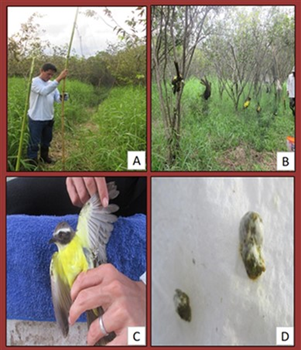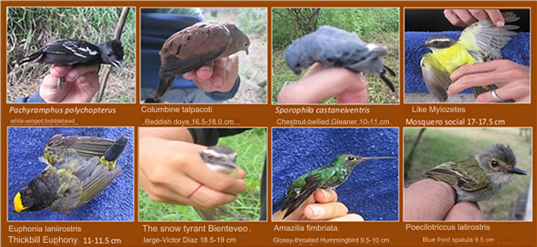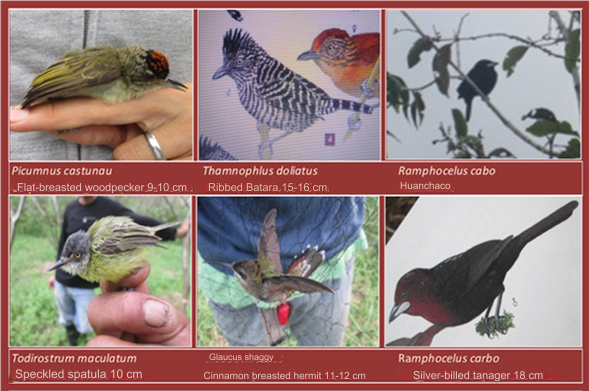eISSN: 2576-4462


Research Article Volume 8 Issue 2
1Instituto de Investigaciones de la Amazonia Peruana (IIAP), Perú
2Universidad Nacional de la Amazonia Peruana (UNAP), Perú
3Universidad Nacional Intercultural de la Amazonia, Perú
Correspondence: Mario PINEDO-PANDURO, Instituto de Investigaciones de la Amazonia Peruana (IIAP), Av. Abelardo Quiñones km 2.5. Iquitos-Perú
Received: June 14, 2024 | Published: June 28, 2024
Citation: Pinedo-Panduro M, Ching CC, Panduro-Tenazoa NM, et al. Observations on the role of birds in the dispersion of Phthirusa pyrifolia hemi-parasite plant of Myrciaria dubia (camu-camu) in loreto-Peru. Horticult Int J. 2024;8(2):45-48. DOI: 10.15406/hij.2024.08.00302
Phthirusa pyrifolia (suelda con suelda), a very common hemi-parasitic species of camu-camu (Myrciaria dubia), was always considered an object of dispersal by birds. Given the limited information on the subject, this study was developed in a flood-prone camu-camu experimental plot, on the banks of the Amazon River in the San Miguel-IIAP Experimental Center. Capture nets were installed between 5:00 a.m. to 10:00 a.m. and 3:00 p.m. to 5:00 p.m. in areas with the greatest presence of birds, with inspections every 30 minutes. Once the captured birds were identified, feces were analyzed to determine the existence of seeds. 14 species were identified, of which only Myiozetetes similes (social flycatcher) had two Ph. pyrifolia seeds in the digestive tract. Regarding dispersion, our observations allow us to deduce that it is carried out by consume of the pulp or pericarp by birds without actually swallowing the seeds, which, attached to the branches of the camu-camu, continue their parasitic development.
Keywords: Amazonia, pest, hemi-parasite, amazonian fruit, ornithochory
Camu-camu [Myrciaria dubia (Kunth) McVaugh] is a native Amazonian fruit tree that grows spontaneously on the banks of black water bodies in Loreto (Peru), a habitat that contains the largest area of natural stands of this species in Peru. This resource has aroused great interest in the national and international market due to the large amount of ascorbic acid (2,700 to 3,000 mg/100g of pulp) contained in its fruits.1
Parasitic plants often influence the productive capacity of agricultural crops. In the case of camu-camu, there are some species of Loranthaceae that cause a reduction in the vigor and productivity of fruit, among which Phthirusa pyrifolia (Kunth) Eichler has become a major pest.
The Lorantaceae botanical family is the most widely distributed group of parasitic angiosperms in the world, with 65 genera and 850 species. Peru has 74 species of Loranthaceae, included in 12 genera;2-4 evaluating parasitic plants in camu-camu flood plantations in the department of Ucayali, found in the community of Pucalpillo 78,320 individuals/ha of Ph. pyrifolia in the community of Yarinacocha 48,839/ha and on high land (not floodable) 46,750/ha. These results confirmed the abundance of Ph. pyrifolia in camu-camu plantations.
Ph. pyrifolia, locally known as suelda con suelda, mata-palo or mistletoe, has many hosts, mainly trees and shrubs, including camu-camu, coffee and citrus.5,6 It is capable of photosynthesizing but obtains water, nutrients and support from the host by penetrating the bark through haustoria that connect with the xylem. Ph. pyrifolia grows on the canopy of trees and reduces the amount of light reaching the leaves of the host, limiting the photosynthetic capacity of the host until it is killed. Depending on the host, it adapts the development and structure of its haustorium, as well as other physiological characteristics.7
As described by Sanchez,4 the stem is cylindrical from base to apex; sometimes it presents furfuraceous lines; the thickness can reach up to 1 cm. The epicortical roots are aerial, which develop on the surface of the stem and branches of the host. In its course, every 3 to 8 cm it forms an appressorium and below this, the haustorium, a specialized structure to absorb nutrients from its host, which is introduced perpendicularly until it reaches the xylem. The haustoria have very fine conductive bundles that come into contact with the structural barriers presented by the host, which they dissolve by means of enzymes they produce, until they come into contact with the xylem. Regarding the leaves, this author describes them as broadly lanceolate, up to 10 cm long and 5 cm wide, with an acute or attenuated apex, obtuse or truncate base, thin, dark green, glossy and with a petiole 1 cm long.
Sánchez et al.8 state that Phthirusa has the capacity to dissolve the components of the cuticle and cell wall of the tissues of branches and stems. Once a seed is inoculated on the surface of the cultivated plant, aided by a gum produced at the internal base of the epicarp, they dissolve the cellular components of the cuticle, cell wall and plasma membrane of the epidermal and meristematic cells until they reach the vascular bundles from where they obtain water and minerals. In addition, they develop epicortical roots that, according to Ramírez,9 can consist of 2 to 4 roots 1 to 1.2 m long on 6-year-old camu-camu plants growing in inceptisol soils. In natural conditions of restinga rain forest (entisols soils), they exceed 3 m in length attached to the branches and stems of the plant, but never reach the soil. This author found that the biological cycle of Ph. pyrifolia in camu-camu, from inoculation to the first fruiting, fluctuates between 240 and 270 days.
The effect of these parasitic plants on their hosts is varied. Infected plants show lower leaf water potentials, stomatal conductance and nitrogen concentration than uninfected plants.10
In a chromatographic study, Costa et al.11 found in leaves of Ph. pyrifolia proteins with effective anti-microbial activity against gram-positive bacteria (Staphylococcus epidermidis, Streptococcus faecalis and Bacillus subtilis), as well as gram-negative bacteria (Klebsiella pneumoniae), fungi (Fusarium laberitium and Rhizoctonia solani).
This research is aimed at increasing knowledge on the propagation and dispersal of Ph. pyrifolia and its interrelationship with camu-camu, which would contribute to the design of strategies and methods for the integrated management of this hemi-parasitic species, considered a pest of several agricultural species.
Study area
The study area belongs to the San Miguel Experimental Center (CESM-IIAP), jurisdiction of the San Miguel-Amazonas River hamlet, District of Iquitos, Province of Maynas and Loreto Region. It is located on the left bank of the Amazon River, upstream from the mouth of the Itaya River, between the coordinates 3°40' and 3°45' South Latitude and 73°10' and 73°11' West Longitude, and with an average altitude of 120 m.a.s.l. Access to the study area is by river, 25 minutes upstream from the city of Iquitos, in a 40 HP motor boat.
According to the Holdridge classification system, the life zone in which the study area is located is classified as Humid Tropical Forest (Bh-T), located in the tropical zone, presenting a humid climate without marked variations in the annual average temperature and without a well-defined dry season.
The natural vegetation consists mainly of pioneer species, with a predominance of caña brava (Gynerum sagitatum (Aubl) P.Beauv), cetico (Cecropia spp.), amasisa (Eritrina spp.), among others.
Plant material A germplasm collection (1.5 ha) was utilized, established between 2001-2004 and evaluated annually for vegetative (plant height, number of branches, crown diameter, etc.) and reproductive (number of flowers, number of fruits, fruit weight, yield) descriptors, as well for as ascorbic acid content in the fruit pulp. This plot, due to its high planting density, had a high level of self-shading, which facilitated the presence of birds apparently responsible for the dispersal of the solder with solder.
Bird capture and assessment of parasitic plant propagation system. To capture the birds, three nets were installed in previously identified areas with the greatest presence of birds. These nets were installed between 5:00 and 10:00 a.m. and from 3:00 to 5:00 p.m., coinciding with the feeding time of the bird species. The nets were inspected every 30 minutes. Once the birds were captured, they were identified taking into account the morphological characteristics of each species. The birds' feces were then analyzed to verify the presence of seeds and the dispersal activity of the parasite species (Figure 1).

Figure 1 A. Installation of nets B. Capture of birds
C. Identification of species D. Analysis of feces.
For the study of the propagation system of the parasitic plant, samples of leaves, flowers and seeds at different stages of maturation were collected and placed in a humid substrate to evaluate germination.
Evaluations of botanical aspects (description of the plant and its organs, reproductive system, taxonomy), growth and development (fruit ripening, seed germination), phenology (foliation, flowering and fruiting) and dispersal (dispersal agents, dispersal species, and description of the dispersal process) were made.
Botanical description
By observation of the organs of the parasitic plant, it was verified that it is the species Phthirusa pyrifolia, described in botanical works. It can reach 1.21 m high, has reddish branches, with prominences on the surface. Leaves are vsimple, subopposite, ovate or elliptic, 4.5-10.5 cm long and 2.4-5.3 cm wide; the apex is obtuse, the base obtuse to rounded;. The petiole is 0.6-1 cm long. The Inflorescence is axillary, with short or sessile peduncles, spike or terminal, in simple spikes, often 2 per axil, 2.4-10 cm long. It produces small red flowers. The fruit is a berry having ovate, elliptical or oblong shape, the color is green when it in development, while at maturity it forms bands of colors, basically yellow at the apex, red at the base (Figure 2).
Germination of of Ph. Pyrifolia seeds
The germination process of Ph. pyrifolia seeds on camu-camu branches was observed in situ. The seeds started germinating after 21 days having been attached to the branches and the survival rate of germinated seeds was 25%. (Figure 3)
Bird species captured
Fourteen species of relatively small birds (less than 20 cm in length) were captured, of which only one species corresponds to the hummingbird type. Sánchez4 in camu-camu grown in the Ucayali region, found nine species of hummingbirds, the most common being Amazilia beryllina.12 (Figures 4A and 4B).

Figure 4a Birds evaluated as dispersers of Phthirusa pyrifloia (welder) in Myrciaria dubia (camu-camu) plantation.

Figure 4b Birds evaluated as dispersers of Phthirusa pyrifloia (welder) in Myrciaria dubia (camu-camu) plantation.
Impact of Phthirusa pyrifolia on the physiology of camu-camu
It is known that the parasitism of Phthirusa pyrifolia alter the plant biochemism and induce a high production of total polyphenols13 as a defense mechanism, but this does not prevent the hemi-parasitic plant in its penetration and colonization process. The penetration process of the parasitic plant into the host tissue is influenced by enzymes that help to disintegrate the structural components of the tissues, including the cuticle, cell membrane and cell wall. It was observed that under extreme conditions of this parasitism, the camu-camu plant dies.
Evaluation of Phthirusa pyrifolia seeds dispersion by bird
The observation of the contents of the digestive tract of the captured birds showed that only the species Myiozetetes similes (social flycatcher) had two seeds of Phthirusa pyrifolia in its digestive tract. In none of the other 13 species seeds in their digestive tract were found. This finding was contrary to what was expected and e proves that the seed dispersal of the species in question is not related to the digestion of its seeds by birds. It is possibly more related to an external physical dispersal that requires further evaluation and analysis. Quesada et al.,14 mentions that birds are the main seed disperser in neotropical ecosystems and it is important to understand their role in the natural regeneration of degraded environments. In that study, 168 birds of 23 resident species (12 families, five orders) were captured. Coincidentally, Myiozetetes similis and Megarhynchus pitangua were found as potential disperser species in this assessment. It is estimated that about 70% of woody plants in the tropics depend on seed dispersal by birds. The passage of seeds through the digestive tract of birds may influence their subsequent germination success.15
Sanchez4 also commented that most of the technical reports and the criteria of people linked to the field agree that dispersal is done by birds, but there are still many questions in this regard in relation to what is observed in the field. How does the bird sow the seeds one after the other along the branch? The present research shows that there is no trophic relationship between the birds and the seeds of the hemi-parasite, which would lead to a propagative dispersal of the species. However, according to the observations of this process of dispersal by birds of Phthirusa pyrifolia, the following were noted:
The hemi-parasitic plant under study presented botanical characteristics, growth and development compatible with the bibliographic descriptions of the Phthirusa pyrifolia species. The time until the beginning of seed germination was three weeks and the seedlings had a high mortality rate.
The capture of birds was more effective when the nets were installed in places with less luminosity where the presence of Ph. pyrifolia was greater. The evaluation of the14 species of birds captured, allowed us to clarify that the ingestion and digestion of seeds is not important in the dispersal of the parasite species.
There was only one isolated case of the presence of two seeds in the digestive tract of the bird Myiozetetes similes. It was observed that the birds (without determining which one had the highest degree among the 14 species) feed on the pulp of the fruits, but without ingesting it. Thanks to the haustoria, the seeds remain attached to the branches before germination and growth. In other words, the birds are involved in the transfer and pulping of the fruits to the branches of the host, in this case the camu-camu.
None.
The authors declare that there is no conflicts of interest.

©2024 Pinedo-Panduro, et al. This is an open access article distributed under the terms of the, which permits unrestricted use, distribution, and build upon your work non-commercially.